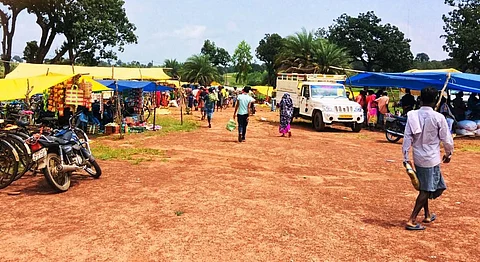

It has been two years since an ambitious programme to convert 22,000 rural haats into Gramin Agricultural Markets (GrAMs) was launched. But only 1,251 have come up till now. This is barely six per cent of the target.
Union Agriculture Minister Narendra Singh Tomar told the Lok Sabha that physical infrastructure or facilities had been provided to 1,251 rural haats so far to convert them to GrAMs. Work on 1,553 other village haats was underway.
Mizoram, Madhya Pradesh, Chhattisgarh, West Bengal and Uttar Pradesh had the highest number of GrAMs completed till date — 245, 163, 127, 111, and 106 respectively, the minister’s reply noted.
States like Jharkhand and Maharashtra, with significant farmer populations, had not developed any GrAM. However, work was ongoing in one rural haat in Jharkhand. No work was ongoing in Maharashtra’s 3,500 existing rural haats, Tomar said.
Then Finance Minister Arun Jaitley had announced a scheme in the 2018-19 Union budget speech to develop and upgrade the existing 22,000 rural haats into GrAMs.
The aim was for small and marginal farmers, who could not access the Agriculture Produce Marketing Committees (APMCS) or wholesale regulated markets, to get fair prices for their produce.
The figures given by the government are disappointing as upgrading rural haats was an alternative to expanding the number of wholesale regulated markets.
The government had stated that expanding wholesale regulated markets may not be feasible, since it was capital-intensive and time consuming.
Access to markets remains a big challenge for small and marginal farmers who comprise more than 86 per cent of the total farmers. They are not always in a position to directly transact at APMCs and other wholesale markets as there are not adequate numbers of such markets.
Farmers who cannot reach the APMCs, are either forced to sell their produce to the aggregators / local traders at prices dictated by them or sell in the nearby rural haats, which are not developed like the APMCs.
This point had come up when the government had brought in the now-repealed farm laws in 2020. These laws allowed the sale of agricultural produce outside of mandis.
Experts had said at the time improving agricultural marketing infrastructure and increasing the number of APMCs in the country was the need of the hour, rather than what the government had done.
There were 6,630 regulated wholesale markets in the country as on March 31, 2017, with an average density of 496 square km per market.
The recommendation to develop the existing rural haats was also made by the committee on Doubling of Farmers’ Income. It had said:
It is recommended to take advantage of the premises of existing 22,000 (approximately) haats across states, to co-host aggregation market platforms under private and public sector organisations, as also by adopting public private partnership models.
The recommendation had added:
The haats may be upgraded into rural level agri-market platforms and be kept outside the ambit of the State Marketing Act, so as to enable them to directly link the farm gate with wholesale terminal markets, national and international. These would also support local retail between farmers and consumers, and direct marketing to supply retail requirements at terminal markets.
Jaitley had said during the budget speech: “In these GrAMs, physical infrastructure will be strengthened using the Mahatma Gandhi National Rural Employment Guarantee Act and other government schemes. These GrAMs, electronically linked to e-NAM and exempted from regulations of APMCs, will provide farmers facility to make direct sale to consumers and bulk purchasers.”
He had added that an Agri-Market Infrastructure Fund, with a corpus of Rs 2,000 crore will be set up for developing and upgrading agricultural marketing infrastructure in the 22,000 GrAMs and 585 APMCs.
Some 73 per cent of the rural haats were operated weekly while 11 per cent were operated on a daily basis according to a preliminary analysis by the government.
The basic facilities in these haats were dismal. Only 14 per cent had a pucca internal road. Just 24 per cent had electricity, four per cent had toilet facilities, eight per cent had a boundary wall or fencing and 15 per cent had a raised platform.